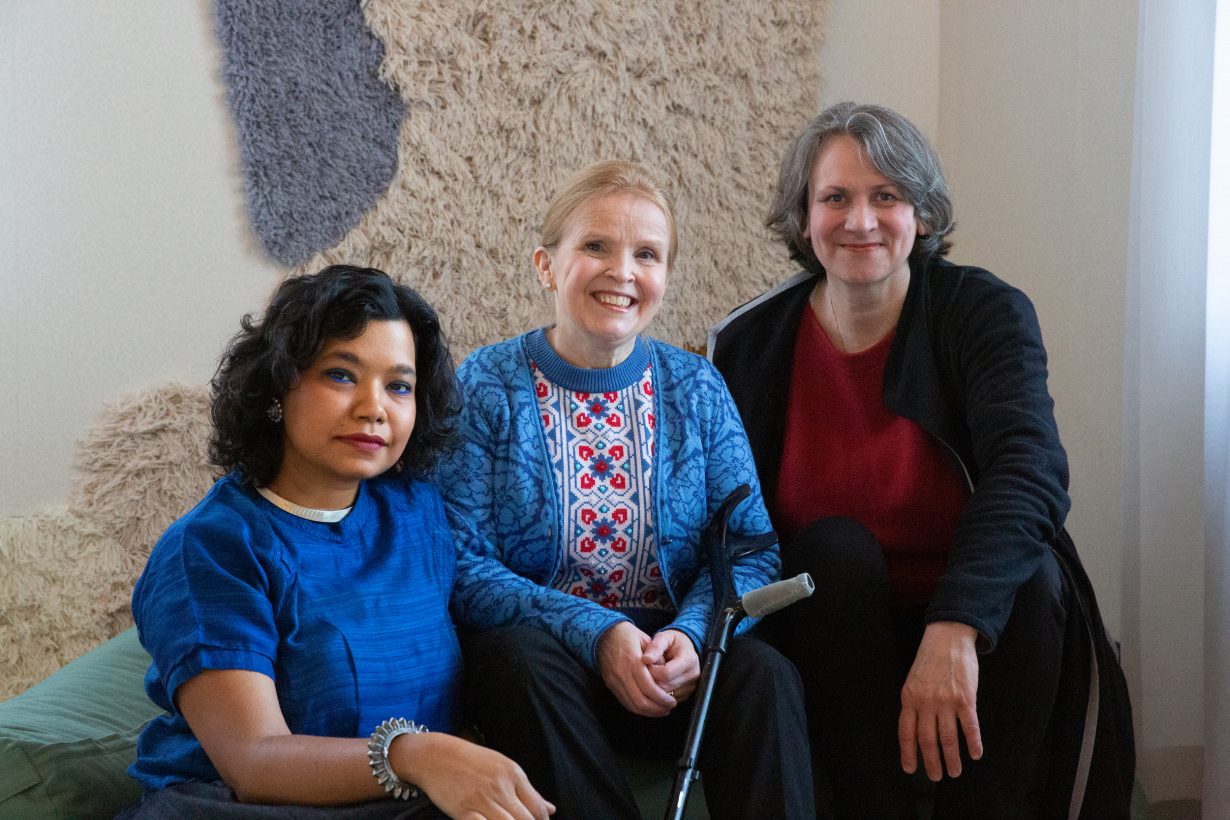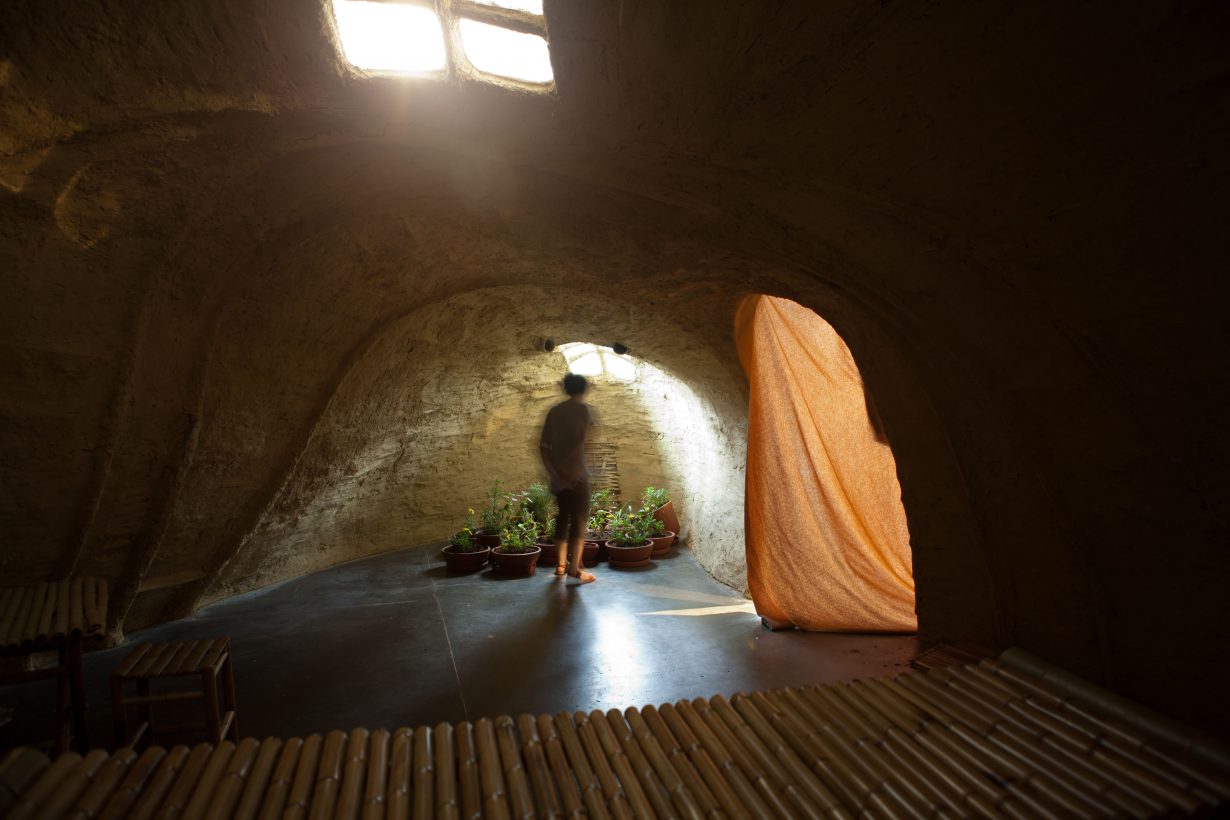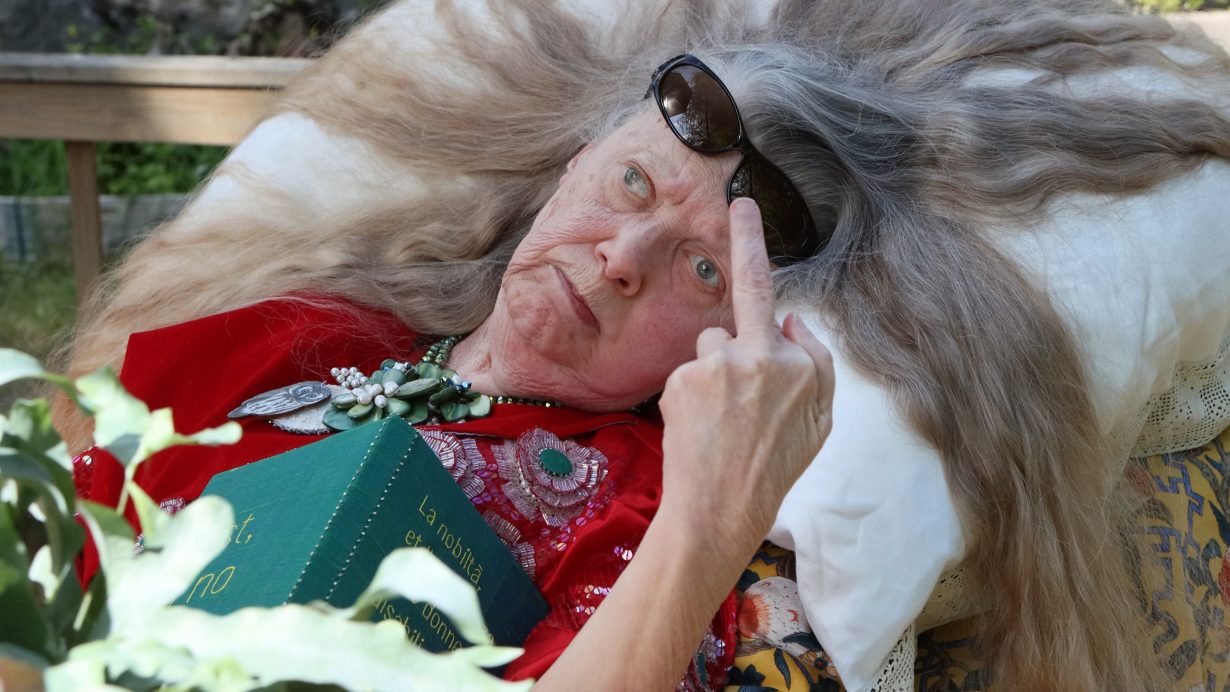ArtReview sent a questionnaire to artists and curators exhibiting in and curating the various national pavilions of the 2024 Venice Biennale, the responses to which will be published daily in the leadup to and during the Venice Biennale, which runs from 20 April to 24 November.
Pia Lindman, Vidha Saumya and Jenni-Juulia Wallinheimo-Heimonen are representing Finland; the pavilion is in the Giardini.

ArtReview What do you think of when you think of Venice?
Vidha Saumya Venice evokes a sense of brazen beauty and the witnessing of an enchanting city ravished by utility that holds itself in repose like the folded wing of a bird or an unseen oar that laps itself in movement at the slightest echo. In these ways, it reminds me of Mumbai, my hometown.
Jenni-Juulia Wallinheimo-Heimonen Venice is so rebellious that it makes a disability activist revel – although it’s not accessible. Venice has an activist soul that thrives and has been refined by more than 1,500 years of challenges to do things differently to other cities. It’s literally a groundbreaking example of unfathomable imagination that has led to innovations and tremendous success. As a user of mobility aids, I can also identify with how Venice must get pissed off at being stared at all of the time.
Pia Lindman I think of the authoritative power of Christianity. I think of a melting pot of Western and Eastern architecture, seen through the lens of European history. Of a human-generated vision of beauty. I think of belonging, how I do not belong to or in Venice, while all Europeans should perhaps feel Venice belongs to their cultural heritage and their lives. I think of a photo from the 1950s of my dad crawling in waist deep snow, almost exasperated with laughter in the face of nature changing the potentiality of his human agency. That is the reality I feel connected to. And I am moved to tears every time I stand in front of the cathedral of San Marco.
AR What can you tell us about your exhibition plans for Venice?
PL, VS & JWH The pleasures we choose, our exhibitionin the Pavilion of Finland at the Venice Biennale, presents ways of challenging sociopolitical and structural boundaries to ignite social discourse through art.
Exploring bodily knowledge(s) that translate internal signals into art; challenging societal norms around identity, utility and belonging; countering hate speech that people with disabilities face in social and health care – we subvert these collective and individual experiences with joy, humour, agency and resilience. By celebrating pleasure as a powerful means of inhabiting, imagining and remaking more plural worlds, our work invites you to confront uncomfortable truths, reimagine the world around you, and join us in reclaiming the pleasure that is rightfully (y)ours.
Embraced as a collective project, our exhibition evolved through the exchange of shared and individual experiences with curators Yvonne Billimore and Jussi Koitela and is connected conceptually and materially through architectural interventions designed by Kaisa Sööt.

AR Why is the Venice Biennale still important, if at all? And what is the importance of showing there? Is it about visibility, inclusion, acknowledgment?
VS Any form of regular convening of people and ideas is important, and efforts must be made to sustain it in ways that maintain the desire to reflect upon and push the boundaries of that culture. To show work at the Biennale is to participate in that culture where the ambition and motivation of artists advances the historical significance of the Venice Biennale.
I first saw international art at such a scale when visiting the Biennale for the first time in 2017, so now that I am showing work here, I feel like I am in a dialogue with the fantastic artists whose work I love, like Kiki Smith, Paula Rego and Louise Bourgeois, who have exhibited in the previous editions of the Biennale, as well as artists and works I was not previously familiar with, who have inspired me since.
JWH The presence of minority artists is always easier to see than their absence. The scale and visibility of the Biennale makes participation important, whether you represent minority arts or global themes.
PL Of course, it is exciting to be involved. However, since an event such as the Venice Biennale operates on multiple levels of mediation and logic, I am always cautious of how the messages within my work will be communicated to audiences. Direct critique of the formulas and politics of any venue has its place, but in making my art, all I can do is let it be shown and hope someone receives it.
AR When you make artworks do you have a specific audience in mind?
VS Audiences encounter a given work of art from their personal, emotional, social, financial and political locations. I make work keeping in mind that my work should be accessible. I hope my work evokes a sense of being seen and heard while fuelling an imagination that may be dormant until that moment of encounter.
JWH Insider humour is an integral element of disability arts, but I’ve been accused of trying to make physically privileged people jealous that they aren’t disabled yet.
PL When working with site specific performances and installations, yes. However, often not only an audience, but a specific place and history are active elements in my work. A good example of recent site-specific work are the collective song performances I have done in Vienna and Helsinki. For the past 15 years, however, my work has also taken on a more propositional aspect: I make art to suggest other ways to create our relations and that another kind of world is possible in the context of humanity, more-than-humans and the universe. This is not to say that I believe art is universal, as this suggests that art can always be experienced in the same way and disregards cultural contexts or even neurological realities of living beings.
AR Do you think there is such a thing as national art? Or is all art universal? Is there something that defines your nation’s artistic traditions? And what is misunderstood or forgotten about your nation’s art history?
VS Although art speaks to specific sensibilities, as a dialogue between itself and the viewer, it holds the potential to speak to many, which could be loosely defined as art being universal. To understand the word ‘national’ in contemporary times is to be aware that it implies power imbalances and the ‘management’ of bodies and minds. With this understanding, one can think there is a difference between ‘national’ and ‘nationalist’ art and between ‘nationally recognised’ or ‘popular within a national imagination’. A common misunderstanding when speaking about art is the rush to categorise art and artists while overlooking these complex power relations.
JWH There is no place in the world for people with disabilities to live equally among others. We are foreigners everywhere. That’s why the culture of people with inborn disabilities that run from one generation to another feels often more familiar to me than the national culture. It’s rare that you randomly come across disability arts in national art history. The educational path to become an artist is like a steeplechase, with most people applying to art universities having years of training and guidance behind them. As children’s art schools and civic colleges are often still in inaccessible buildings, it’s hard for people with disabilities to start competing from the same line. Fortunately, ‘outsider art’ exhibitions have provided a platform for striking artists with disabilities.
PL National identities are constructs formed to serve one or another political aim. At the same time, as it is human to need to feel like one belongs, narratives about nationalities – however imaginary – do become sources for identification. These narratives are powerful tools to direct collective force and art has often been used to yield this power. Making my art, I walk a tightrope between this potentially dangerous form of belonging and the impossible form of universalism. If there is something forgotten about our nation’s art history, it is the multiplicity of identities inside our fluctuating national borders. For example, lesser-recognised histories of Roma, Sámi and Russian presence in Finland have often been left out of our polished, singular national narratives.

AR If someone were to visit your nation, what three things would you recommend they see or read in order to understand it better?
VS I recommend reading Annihilation of Caste [1936] by Dr. B. R. Ambedkar and couplets by the iconoclastic poet-saint Kabir.
JW I recommend testing the three types of Finnish silence. Firstly, the caring, peaceful silence by visiting Helsinki’s Oodi library – a public living room where people from all backgrounds are represented, both in books and in reading corners. Then the natural silence of standing in a forest amid slow snowfall, with nature’s sound deprivation encouraging you to listen what’s going on inside your head. Thirdly, the awkward silence, like when you are doing an artistic performance on the subway while passengers are staring at the dark tunnel wall and pretending that they can’t see or hear you.
PL Go to Kirkenes (Kirkkoniemi), in Finnmark, Norway. Continue East to Svanvik and cross the ice on the Paatsjoki River. Stop at the Russian border in the middle of the river. Look East, where, some kilometres across the river, you will see the town Nikel (Nikkel) in Pechenga (Petsamo), a nickel mining town built during the time it belonged to Finland and that since 1945 has belonged to Soviet Union/Russia. Fly over the region North of Nikel and witness the polluted and barren land – from where the Indigenous Skolt Sámi have long before been expunged. The pollution extends from Nikel all the way to (and into) the Arctic Sea.
AR Which other artists have influenced or inspired you?
VS Artists and poets such as Louise Bourgeois, C.K. Rajan, Kiki Smith, Vikrant Bhise, Anurag Minus Verma, Lal Ded, Daniil Kharms and Jacinta Kerketta.
JWH Iiu Susiraja, Judith Scott and of course Frida Kahlo.
PL William Pope.L, David Hammons, Hélio Oiticica and Lygia Clark. My professors at MIT: Krzysztof Wodiczko, Muntadas, Julia Scher, Dennis Adams and Joan Jonas. Finnish performance artists Pentti Otto Koskinen and Roi Vaara and performance groups Homo S and Record Singers. My friends, peers and colleagues Nomeda Urboniene and Geddiminas Urbonas, Jean-Ulrick Désert, Rita Ponce de León, Bartaku, Sasha Huber, Leopoldo Pizarro, Emily Jacir, Sanford Biggers, Daniel Bozhkov, Rene Gabri, Ayreen Anastas, Ellen Harvey, Mike Rakowitz, Kelly Dobson, Trevor Paglen, Heidi Fast, and Jesal Kapadia.
AR What, other than your own work, are you looking forward to seeing while you are in Venice?
VS I look forward to the feverish, starry excitement of the opening week of the Venice Biennale with artists, friends, and colleagues.
JWH I want to go and say hi to the famous Venetian mummy of ‘The short man of the Rialto Bridge’, who also lived with osteogenesis imperfecta. His body, which perhaps is the only documented case of a human taxidermied body, is on display at the Museum of Pathological Anatomy ‘Andrea Vesalio’ in the Scuola Grande di San Marco.
PL I look forward to seeing the main exhibition Stranieri Ovunque – Strangers Everywhere curated by Adriano Pedrosa, and especially the collateral exhibition South West Bank, Landworks, Collective Action, and Sound organised by Artists + Allies x Hebron in collaboration with Dar Jacir for Art and Research in Bethlehem. I would also love to see more ‘un-nation’ pavilions emerge, as with the Sámi pavilion in 2022.
The 60th Venice Biennale, 20 April – 24 November